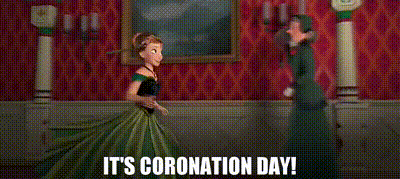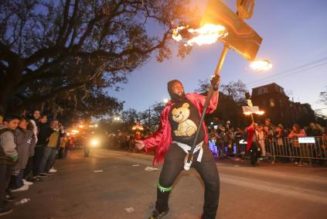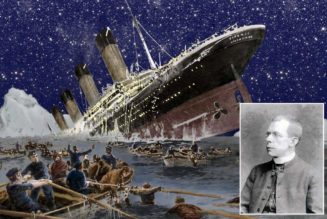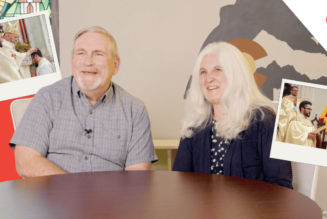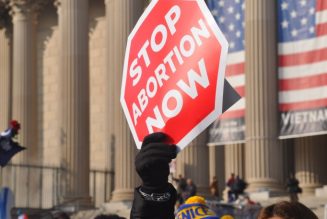Happy Friday friends,
Tomorrow is coronation day, and as you might expect it is a big deal for all of us in the Condon house, since we all have UK passports, and since our daughter has an affinity for a certain irritating Disney film.
I’m looking forward to what promises to be an immense spectacle and celebration — even if the actuarial tables suggest it probably won’t be a once in a lifetime event for our family.
The ceremony itself has been subject to numerous tweaks and updates since the late Queen was crowned in the 1950s, but on the whole these seem to have been done sensitively, with an eye to keeping as many of the traditions and trappings intact as possible — this is the monarchy we are talking about, after all.
One exception I would make to this is the augmenting of the “homage of the peers” in which the nobility make their obedience to the new sovereign. In a plan apparently dreamed up by Justin Welby, the Archbishop of Canterbury, the whole country will instead be invited to make an “homage of the people,” swearing to bear true and faithful allegiance to himself and his heirs and successors.
It’s the silliest possible idea Welby could have come up with in the name of audience participation. Not only does it invite an inevitable tide of social media ridicule, which it will at the exact moment it takes place, but it gets the whole point of the coronation exactly backwards.
I remember well as a 16-year-old placing my hand on a Bible and swearing to bear true and faithful allegiance to her [late] majesty and her successors in law. The whole point of that formulation is that it carries through to Charles as her lawful heir.
The peers traditionally make their homage in a nod to the importance that the new sovereign be able to command their loyalty. In pre-Norman times, the new king actually had to be elected by the Witan, the body of the country’s lords spiritual and temporal.
But as a commoner already pledged to serve the crown, there is no need or purpose for me to swear again.
And the loyalty oath inverts the entire emphasis of the coronation, in which Charles is the one assuming formally a host of new responsibilities and obligations to his subjects, swearing himself to their service, not the other way around.
And, I’d add, it’s just bad psychology. Inviting the entire country to swear allegiance to the new king actually plants a question in everyone’s mind about whether or not they want to. The stability of the monarchy rests on its endurance, its sense of timelessness, the fact that it always just is.
If you are looking to shore up the king’s position, you want people to take his seat on the throne for granted, not invite them to consider if they endorse him personally.
Anyway, I won’t be participating in anything so absurd as a bid to “democratize” participation in a coronation. But I will be watching, and we will have a party afterwards.
It’s coronation day, after all.
The News
One of the unique things about the crowning of a British monarch is that it takes place within a Christian liturgy.
In all history, only the monarchs of England, France, and the Holy Roman Emperors have been both crowned and anointed with oil as part of a Christian investiture — and with the Holy Roman Empire long gone, and the French more prone to cutting their kings’ head off than crowning them these days, tomorrow’s event is now truly one of a kind.
—
When the first bishop of a new diocese in Nigeria was installed last month, he walked into one of the most difficult jobs imaginable.
It’s a tall order, even by Nigerian standards, where violence against Christians and the Church is often more of the norm, rather than the exception.
Our Nigeria correspondent, Fr. Justine John Dyikuk, brings you the story from the ground.
—
The Sovereign Military Order of Malta elected a new Grand Master this week, capping off years of internal upheaval, division, and reform.
Dunlap’s election is a first in a lot of ways: he’s the first grand master not of noble birth, following reforms brought in by Francis when he issued a new constitution for the knights last year. He’s also the first GM not elected for life, instead he will serve a ten year term.
It’s been a long five years for the order, since a 2017 dispute between the then grand master and grand chancellor rocked its leadership, split its members, and dragged the pope into the sovereign internal workings of the SMOM. But now it looks like the knights are back in the saddle and all facing the same way.
—
Bishop Joseph Perry, auxiliary bishop of Chicago, has been named the new chairman of the USCCB’s ad hoc committee against racism, we reported this week.
Perry has a long history of working to fight racism, and his qualifications for the job are clear. But the manner and timing of his appointment are interesting. There’s no word on why Archbishop Fabre asked to step down, or was asked — though he has had the gig for some five years now.
And it seems a strange time of year to make a switch. I’d have thought this was the sort of thing that would happen over the course of the USCCB’s next meeting, scheduled for June. But it’s possible there was a timing issue: the bishops were told of Perry’s appointment just two days before he turned 75, and had to offer his resignation to Rome.
It’s possible Broglio wanted Perry for the job and wouldn’t have had the option of appointing him if he’d already put his offer to retire in for papal consideration, and so had to act out of season, as it were.
We don’t know, yet. But we’re very curious and going to be asking around about it, you can be sure. And for the moment, the USCCB isn’t responding to questions about the appointment, or acknowledging that it has happened, even though we’ve confirmed it several times over.
—
This time last week, the permanent secretariat of the Synod of Bishops published the final report of the continental phase of the synod on synodality. But this document didn’t come from Africa, Asia, or Europe, it came from the “digital continent.”
I’m not going to lie to you, when I first saw the announcement, I rolled my eyes and thought this was probably a gimmick, and probably a very expensive one at that. But I started reading the report and I started to get the impression that the motivations behind the digital synod were actually pretty reasonable.
Online evangelization is a real thing, and something the Church does need to get better at. Social media may often be toxic, silly, vicious, and trivial, but it is also a real thing and a direct line into millions of people’s lives every day. The Gospel needs to be there, too.
But reading the report was heavy going, we found. Many of the synodal reports can be rather jargon heavy, and full of the contorted grammar and $10 words you normally get when a grad student asks a “question” at the end of a speech. Parts of it were just hard to understand:
“The ecclesiology of Francis and, therefore, his pastoral proposal invites us to move from a self-referential, sedentary, and static pastoral to an open, itinerant, and ecstatic one, thus concretizing that permanent missionary process that wants to go towards everyone and reach the last ones, the forgotten ones that God does not forget.”
Maybe you know what concretizing that permanent missionary process means, but we needed a little help.
—
Indian Catholic leaders and Vatican officials sat down in Rome this week to discuss the ongoing liturgy war in the Syro-Malabar Church.
In his report this week, Luke Coppen looked at the state of the dispute, and the likely possible steps the Vatican might take to end the roiling conflict over the Vatican’s attempt to force the S-M clergy to abandon their Western habit of facing the people during Mass.
As Luke reports, this could include the pope moving to break up the Archeparchy of Ernakulam-Angamaly, the Church’s most important diocese.
The first rule of Fight Club
Returning from his visit to Hungary on Sunday, Pope Francis was asked during the seemingly obligatory, and often controversial, in-flight press conference about the prospect for peace in Ukraine.
Well, it’s public now, and everyone is talking about it.
Russian and Ukrainian government officials, and Russian Orthodox leaders, tripped over each other in their hurry to deny any knowledge or involvement in the secret papal peace initiative, while a close papal advisor told an Italian newspaper he’d personally worked on a seven-point plan to end the conflict, and predicted some kind of resolution within months, if not weeks.
As confusion and speculation mounted, the Vatican Secretary of State, Cardinal Pietro Parolin told journalists he was “surprised” by the Ukrainian and Russian denials since “to [his] knowledge, they were and are aware” of what the Vatican has been up to.
Now, nothing is ever entirely certain when talking about war and high level diplomacy. But there seem to me to be three basic possibilities here.
1. There hasn’t been, and isn’t any actual papal peace plan in operation. Pope Francis said what he said on the plane as a kind of papal wish-casting, in an effort to speak a long-cherished project into being. The denials from all sides are genuine confusion by the Ukrainian and Russian governments, and the Vatican push back is Francis’ cabinet rallying around the boss, doubling down on what is, after all, an unfalsifiable claim.
This seems highly unlikely to me. The comments by Stefano Zamagni, former president of the Pontifical Academy of Social Sciences and a longtime Francis confidant, are too detailed (albeit a little hubristic) to be total BS.
2. Francis has a plan in a drawer, written by someone like Zamagni, and he has been trying very hard to get either and both sides of the war interested in hearing him out — including by trying to sell senior members of the Russian Orthodox Church on the idea, and get him through the door in Moscow. But the pope’s efforts have met with little more than polite refusals and awkward silences.
In this scenario, his comments on Sunday were Francis’ bid to put some voltage into his overtures and see if he could get the international media behind the idea and maybe get some real players to come to his table.
It’s possible, I suppose. But it would be a very calculated and very high stakes roll of the dice by the pope — one that doesn’t appear to have paid off.
3. Francis and the Holy See diplomatic corps have been engaged in very quiet, very backroom conversations with representatives from all sides. Everyone agrees the Russian invasion has turned into a charnel house for Moscow, and created a slow motion humanitarian disaster of centennial proportions. No one thinks it can go on forever — Kyiv is witnessing the systematic rape of her people and land, and Moscow doesn’t have the men and ammo to keep it up indefinitely.
Neither side can publicly countenance some kind of truce, but someone, somewhere, has to start talking seriously about the reality of the situation — and the Vatican has managed to get itself going as a go-between for first contacts.
In this case, buoyed by any kind of progress and keen to show peace could be possible, Francis just couldn’t resist tipping his hand a little to the press, and in doing so he seems to have shot his own fox.
—
For myself, I suspect the truth is somewhere between 2 and 3. Maybe closer to 3 than 2.
Attempting to quietly steer a multi-pronged effort to bring Russia and Ukraine to the negotiating table, as Zamagni has claimed, by enlisting the US on one side and China on the other, is exactly the kind of diplomatic 3-D chess the Secretariat of State sees as its forte.
That the plan would also be complex to the point of implausible, highly contingent on the good faith of known bad actors, and driven by papal imperative would also be right in line with Vatican diplomatic tradition.
And, looking at what Francis actually said, including his winking comment about not “only talking about Little Red Riding Hood” with the former Russian Orthodox foreign minister, it seems clear the pope felt he had something real to talk about. Though whether he should have said anything at all is another matter.
To tell a plane full of reporters that you’re up to something that is “not public” is to make it public, as the pope surely knew. And, generally speaking, the key thing about secret diplomatic talks is: they have to stay secret if you want them to go anywhere.
Russia, for sure, does not want to be seen to be backing down from its (wholly illegal and utterly barbaric) invasion. While it may be feeding its young men into the meat grinder faster than Russian mothers could ever replace them, the overwhelming concern for Moscow would seem to be Putin’s ability to claim some kind of “victory.”
And I can easily believe that the Russian Orthodox Church’s leadership doesn’t want to bolster the Bishop of Rome’s claim to be the real soft power center on the global stage.
But the real issue here is Ukraine. As I have been saying for months, Pope Francis’ call for the Ukrainian president (and people) “to be open to serious proposals for peace” is a bigger ask than I think is widely aknowledged. And Zamagni said the quiet part out loud this week, when he rather offhandedly admitted that no deal would be “perfect” but an “unjust peace is better than a just war.”
I’m not sure I agree, and I am sure many Ukrainians don’t — and never could. At least as things stand.
For sure, any kind of ceasefire will involve some concession of territory by Ukraine, be it Crimea through a return to the status quo ante, or more likely an acceptance of Russian control of territory currently occupied.
And people have been good at pointing out that no country should be asked to accept the annexation of some part of itself as a reasonable price to buy off an invader.
But the land isn’t the point. It’s about the people. For a start, there are the people living in the occupied regions of eastern Ukraine who would, in effect, be offered as a kind of ransom payment to Putin, along with their homes, farms, towns, and cities.
Worse, far worse, even, is the fate of the thousands of Ukrainian children Russian forces have kidnapped since the invasion began, shipping them off to either occupied territories or to re-education camps in Russia itself.
The Ukrainian National Information Bureau says at least 16,000 kids have been taken.
Some U.S. estimates put the number closer to 400,000.
Nearly half a million children. Taken.
You might ask a country to cede territory for peace. That would be imperfect, unjust even. But plausible in the face of harsh reality. But no one, anywhere, I hope, can imagine seriously that you can ask a people, its families, to accept the surrender of its little ones as the price of anything. To do so would require universal inhumanity on all sides.
And, so long as that is the case, Zamagni is entirely wrong about an unjust peace being preferable to a just war. Any mother, father, brother, or sister would, and should, fight with every breath and every bullet to get their kid back. I would, anyway.
Of course, it is exactly on the question of returning Ukraine’s stolen children that Francis tipped his hand on Sunday and said he was doing “all that is humanly possible” to bring about.
But if he was making half the progress his supporters have claimed in recent days, those children would likely have been better served had the pope said nothing about it.
Royal eccentrics
King Charles, I learned from JD and Michelle this week, has something of a low reputation across wide swathes of the American public consciousness.
I had assumed that this was because popular conception of the man was formed by the National Enquirer, early seasons of Oprah, and a — I am trying to be kind here — very one-sided version of the naufragium of his first marriage, delivered by an highly unreliable narrator.
I’ve since been told people’s sense of Charles is now more likely to be (mis)informed by “The Crown,” a popular internet television soap opera in which the king is, I am told, given an unflattering portrayal. I haven’t watched the program, because I have better things to do with my life, like watch “Indian Matchmaking.”
But I’d just remind you all that “The Crown” is fiction, and just because you saw it on Netflix doesn’t mean it happened that way. (Obviously not “Indian Matchmaking,” I wouldn’t watch it if it wasn’t real.)
Back in the UK, Charles is more often thought of as a bit of an eccentric, a man who talks to plants and has unusually strong opinions about landscape gardening and architecture.
He is, I will concede, probably a bit of an oddball, though being born and bred to a lifetime of public service and inescapable public scrutiny probably makes a man a little weird. Consider the Japanese emperor Naruhito, who, I learned this week, is something of an eccentric himself.
According to The Times (the actual Times, not that rag out of New York), as a young man and heir to the Chrysanthemum Throne, Naruhito spent some time in Britain in the 1980s, at Merton College, Oxford, where he wrote a thesis on the study of navigation and traffic on the upper Thames River in the 18th century — bound to come in handy as emperor of Japan, I’d have thought.
But he also managed to take some time to quietly slip up to Scotland for a private hunt for the Loch Ness monster, beginning with a private viewing of a collection of footage and pictures purporting to show old Nessie.
This might seem a deeply unserious pursuit to you and me, typical of a royal dilettante.
But, given the recurring problem Tokyo has with giant lizard attacks, I would submit that studying the Loch Ness monster is a more obvious preparation for his future role than counting barges on the Thames.
Naruhito did not, it seems, find Nessie, though The Times reports that his sister led a follow-up expedition a few weeks later.
It is, I know, tempting to dismiss the very idea of monarchy as a silly institutional holdover in our modern world, and sneer at what few kings remain as a clutch of privileged weirdos. But if you look over the schedule of someone like Charles, you will conclude that it is a punishing round of public appearances he’s keeping, and all for good causes, working longer hours than even I do — and I picked this gig because I love it.
King isn’t a job I’d relish, however nice a house comes with it.
And there is zero chance I could spend the day shaking hands with strangers, many of whom publicly disliked me and my recently deceased mother, and somehow manage to keep it together and just redirect my inner fury at a leaky pen.
More to the point, the institution of monarchy speaks to something romantic in our collective psyche. People want a king — for better or worse. Even the Biblical children of Israel, already provided with a land, the Law, and judges to serve their needs, demanded a man in a crown to follow into battle.
It’s just human nature.
We in America like to think we’re above the pageantry and flummery of a coronation, but the truth is we aren’t. And, in our own way, we actually do a pretty amazing job of it when we want to.
See you next week,
Ed. Condon
Editor
The Pillar
Comments 18
Services Marketplace – Listings, Bookings & Reviews

